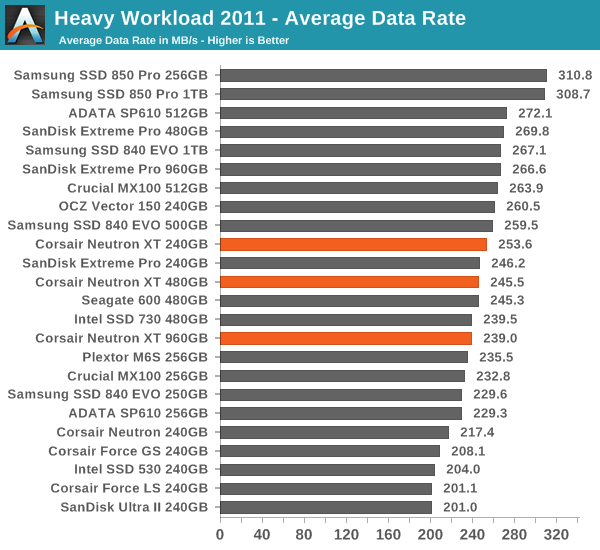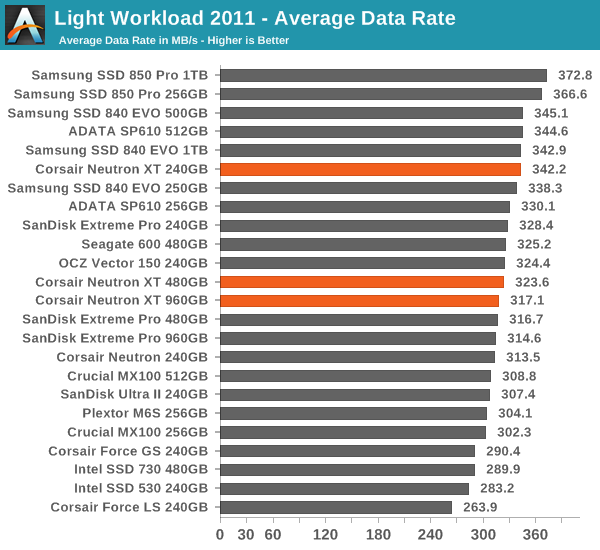Corsair Neutron XT (240GB, 480GB & 960GB) SSD Review: Phison S10 Debuts
by Kristian Vättö on November 17, 2014 9:00 AM ESTAnandTech Storage Bench 2011
Back in 2011 (which seems like so long ago now!), we introduced our AnandTech Storage Bench, a suite of benchmarks that took traces of real OS/application usage and played them back in a repeatable manner. The MOASB, officially called AnandTech Storage Bench 2011 – Heavy Workload, mainly focuses on peak IO performance and basic garbage collection routines. There is a lot of downloading and application installing that happens during the course of this test. Our thinking was that it's during application installs, file copies, downloading and multitasking with all of this that you can really notice performance differences between drives. The full description of the Heavy test can be found here, while the Light workload details are here.

The same story continues in our 2011 Storage Benches. The Neutron XT is an upgrade – and actually a fairly substantial one – from the Force LS, but it doesn't break any records. Also, what's a bit surprising is that the performance drops as the capacity increases because the 240GB is the fastest of the Neutron XT family. This isn't uncommon because the larger capacities have more LBAs to track, which requires more processing power for internal tasks, but it's still something that's worth noting.











56 Comments
View All Comments
hojnikb - Monday, November 17, 2014 - link
At this point, we have a better chance of finding Loch Ness Monster than getting sf3700 :)eddieobscurant - Monday, November 17, 2014 - link
epic !!!glugglug - Monday, November 17, 2014 - link
Any endurance testing done?I have a Neutron 512GB (not GTX) and am pretty disppointed at what the wear leveling indicator from SMART data is telling me..... it looks like the 512GB Neutron has an expected write endurance of only 100TB?
Kristian Vättö - Monday, November 17, 2014 - link
I haven't done any endurance testing, but Corsair is rating the Neutron XT at 124TB (according to The Tech Report). Note that the SMART data isn't usually an indication of an expected failure as the threshold has been set by the manufacturer for warranty reasons, so they can determine whether you've exceeded the endurance rating. In that light 100TB is pretty good because most drives are rated at around 70TB or so.Joepublic2 - Monday, November 17, 2014 - link
I'm disappointed to see them dropping the 5 year warranty on the Neutron line. I bought a Neutron and a Neutron GTX for myself and a few dozen for various clients primarily due to the 5 year warranty. Expected endurance figures mean nothing to me as a user if the company isn't willing to back it up with a appropriate warranty.Kristian Vättö - Tuesday, November 18, 2014 - link
Actually, there was an error in the reviewer's guide, so the warranty is indeed 5 years similar to the original Neutron series. I've updated the article as well.glugglug - Sunday, November 23, 2014 - link
That is very reassuring.One other disturbing thing is the raw read error rate reported in SMART. It starts out looking good after a cold boot, then gradually drops to a value of "1" as the system gets a higher uptime. I think this is actually calculated wrong, being a direct mapping from the raw value, which is always identical to the "Soft ECC Correction Rate" raw value (sitting at ~250,000 after about a month of uptime), instead of being calculated based on the rate of change in that raw value like its supposed to be. Corsair SSD Toolbox labels that counter as "informational only", while CrystalDiskInfo, Stablebit Scanner, & other tools complain when the nominal value crosses the apparent manufacturer suggested threshold of "6" after a week or so.
Restarting Windows does NOT reset the counter -- it gets reset only by a cold boot.
extide - Monday, November 17, 2014 - link
That wear leveling indicator has very little to do with ACTUAL flash lifetime. It is mostly to do with giving the manufacturer the ability to determine when warranty has expired.sonicmerlin - Monday, November 17, 2014 - link
It's really kinda cool these things have quad core processors now.On a side note, does anyone know when someone other than Samsung is going to release 3D NAND?
Kristian Vättö - Tuesday, November 18, 2014 - link
IMFT (i.e. Micron and Intel) is next year and so is SK Hynix. Toshiba/SanDisk is H1'16.